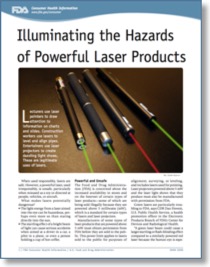Home
A comprehensive resource for safe and responsible laser use
US: Bakersfield (Ca.) paper advocates restrictions on purchasing laser pointers
The paper suggests requiring retailers to restrict access, putting them in a cage or behind a counter in order to "take away the 'anonymous' nature of the purchase and drive home the serious concerns about their use.
From the Bakersfield Californian. The paper also ran a news story April 11 2019 about the hazards of laser pointer misuse against aircraft.
Canada: Looking at "all possible options" to fight laser incidents; perhaps a ban and mandatory labels
The statement came after six laser incidents over two days earlier in the month, at Montreal’s Trudeau Airport. Garneau said these made him “very, very mad.”
A Transport official said the options include a ban on importation of powerful lasers, mandatory warning labels, and stronger penalties for those who are caught.
Garneau noted that it is hard to catch a laser perpetrator, making prosecutions “few and far between”. He believes that some people are not aware of the bright-light danger of laser light, but that others “know darn well what they’re doing” and are trying to “provoke something.”
Transport Canada currently has a program called “Not-a-Bright-Idea,” trying to educate the general public about the risks and legal consequences of aiming lasers at aircraft. Since implementing the program in May 2016, laser incident numbers have dropped. There were 590 reported incidents in 2015, 527 in 2016, and 379 in 2017.
Garneau said that despite the 28 percent drop, Transport Canada must do more, and that is why they are exploring other options.
From 660 News and AVweb
Note: In response to a LaserPointerSafety.com request, an email address for interested persons was provided: “Transport Canada is exploring options to reduce laser strikes. Canadians and industry members can provide information to the Civil Aviation Communications Centre by emailing: services@tc.gc.ca”
UK: "Call for evidence" response summarizes many groups' views on laser eye, plane incidents; sets forth actions
The U.K. government published on January 8 2018 a 14-page report on laser pointer safety and potential regulation. The report includes two new actions the government will take to reduce the number and risk of unsafe laser pointers:
1) “strengthening safeguards to stop high-powered lasers entering the country”, and
2) “working with manufacturers and retailers to [voluntarily] improve labeling.
Separately, the U.K. government published the Laser Misuse (Vehicles) Bill on December 20 2017. This makes it illegal to point a laser at vehicles, with a prison term of up to five years and an unlimited fine.
“Laser pointers: call for evidence - government response”
From August 12 to October 6 2017, the Department for Business, Energy and Industrial Strategy opened a “Call for Evidence” consultation. BEIS set forth 19 questions, asking the public to give their views on laser pointer hazards and what actions to take.
The January 8 2018 government response summarizes the 265 responses received.
The report is especially useful because it incorporates the views of many disparate groups: pilots (64% of respondents), “concerned members of the public” (14%), professional laser safety advisors (9%), users of laser pointers (6%), ophthalmologists (6%), and Trading Standards authorities (2%).
The report then distills these views, finding surprising commonality. It is a good overview for the non-expert on two topics:
1) Actual laser pointer hazards — separating fact from fear
2) Potential actions to reduce the number and severity of laser pointer injuries and incidents — including what actions may not work (e.g., licensing).
We have summarized the findings below (click the “read more” link). However, reading the complete document is well worth the time of anyone interested in this issue.
Click to read more...
UK: Laser pen imports to be more restrictive
In addition, “new measures are also being introduced to tackle the sale of unsafe pointers, including more stringent testing.”
The move was supported by the British Air Line Pilots Association (BALPA).
It may help reduce the number of laser pen illuminations of trains (578 incidents were reported between April 2011 and November 2017) and eye injuries (more than 150 reported since 2013, mainly involving children).
Consumer Minister Margot James said the ministry is “going further than ever before” to police the sale of unsafe lasers.
The Argus quoted Professor John O’Hagan, of Public Health England’s laser and optical radiation dosimetry group.He said: “Over time we have become increasingly concerned about the dangers of growing numbers of unlabelled and incorrectly labelled high power laser pointers being bought by the public. It is tragic that we continue to see eye injuries, especially in children. Laser safety experts at Public Health England have worked closely with local authorities in stopping large numbers of these lasers reaching UK consumers. The extra protections proposed should help even further - if you have a laser and you don’t need it, remove the batteries and get rid of it.”
From The Telegraph and The Argus. The stories seem to be a result of the U.K. government publishing, on January 8 2018, a response to their fall 2017 Call for Evidence. The government response included the increased import enforcement actions.
See also the December 2017 news of a new U.K. law that provides stronger penalties for aiming at aircraft. The new import/consumer initiative seems to be part of the government thrust against illegal and overpowered laser pens.
US: UPDATED - FDA wants to allow only red laser pointers, calling all other colors "defective"

FDA’s primary concern is green lasers’ interference with the vision of vehicle operators including pilots. Green lasers are involved in over 90% of incidents where pilots reported to the Federal Aviation Administration (FAA) that they saw or were illuminated by laser light during a flight. (The charts below were added in January 2017 after the 2016 FAA final numbers came out.)
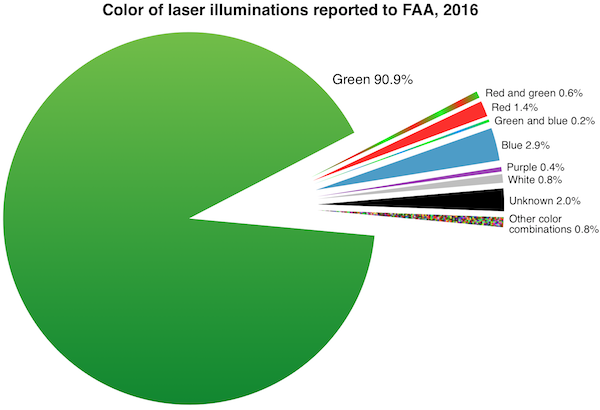
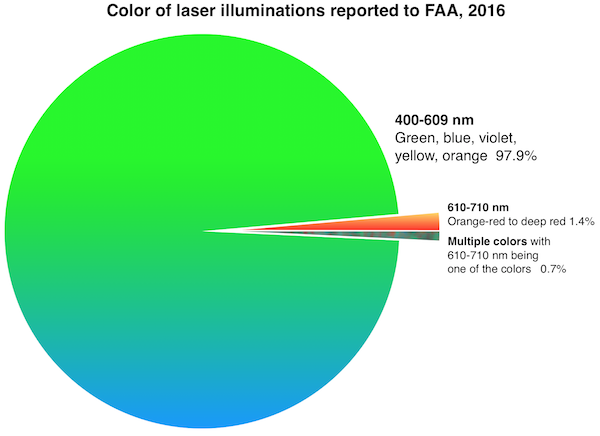
FDA is also worried about blue lasers which can have greater visibility to night-adapted eyes than red lasers of equivalent power.
Thus FDA is applying the “defective” label — giving them added authority over potentially injurious products — because of what they consider to be a well-known, established public safety hazard to operators of vehicles, aircraft and watercraft.
What FDA is trying to accomplish
FDA has two main goals:
1) “Turn back the clock” to the 1990s and early 2000s when almost all laser pointers were red. According to the agency, red light has the least interference with pilot vision, compared to equivalent-power green beams which can appear up to 28 times brighter. During this period there were dozens or low hundreds of reported laser/aviation incidents per year, compared with 7,703 incidents in 2015 and 7,442 incidents in 2016.
2) Make it much easier for customs and law enforcement to identify illegal laser pointers simply by their color. Red and orange-red laser pointers would be permitted; all others would be prohibited for general sales.
In addition, FDA sought to address requests from legislators including Senator Chuck Schumer (D-NY). After high-profile incidents, lawmakers have written to FDA, asking for a ban on green pointers due to their vision-blocking abilities being a risk to pilots and passengers.
Who would be affected
FDA’s proposed color-based prohibition would only affect the manufacture, importation and sales of laser pointer products introduced into commerce. Although pointers fall under the FDA’s “surveying, leveling and alignment” (SLA) control, only pointers as defined by FDA would be restricted to red. Standard SLA equipment would not be affected — they could use any color beam.
Individuals such as hobbyists who manufacture their own laser products for their personal use would be free from FDA laser product regulations. This is because such individuals would not be considered manufacturers by FDA.
Since federal law cannot control individual use or misuse, states and localities could impose their own regulations. (A few states and localities already have their own restrictions on use and/or possession; these are not currently based on the color of the laser.) One benefit of FDA’s proposal is that any new state and local laws could “piggyback” on FDA’s color-based restrictions. That would make it easier for local law enforcement to use color to easily identify whether a person possessed a prohibited or permitted laser.
FDA’s proposal and rationale was stated in draft amendments presented October 25 to an FDA advisory panel known as “TEPRSSC”.
Click to read more...
Australia: Study shows inexpensive green laser pointers are mislabled and significantly over-powered
The researchers purchased eight laser pointers from sources including electronics stores and online stores. They bought four lasers with green beams and four with red beams. The cost of each laser was less than AUD $30 (USD $23).
All of the lasers were advertised to have a maximum output power of either less than 1 mW or less than 5 mW. The green laser pointers’ actual output power measured from 51 to 127 milliwatts. Dr. Fox said “At that upper level, the beam would cause catastrophic retinal damage.”
Apparently much of the green lasers’ power was in the infrared. These types of lasers work by generating non-visible infrared light which is then converted by a crystal into visible green light. A filter is normally used to block the infrared light, and only let the green light through. However, “[t]he research team found that imported laser pointers were poorly made, with manufacturers tempted to skip installing infrared-blocking filters to hold down costs.” The researchers did not measure how much of each lasers’ output was in the visible, and how much was in the infrared.
The 127 milliwatt green laser was labeled as a Class 2 device, with maximum output power of 1 mW. In a previous study from the U.S. NIST, the highest power output they measured was 66.5 mW from a green laser labeled as having a maximum output power of 5 mW.
Three of the four red laser pointers were found to be within the legal limit of 1 milliwatt. The fourth red pointer was about 8.5 milliwatts. The researchers felt that the red lasers’ spots were less focused than green lasers, meaning there was less risk of retinal damage. Also, red lasers use diodes. The maximum power output of these diodes is limited; excessive current will destroy the diode’s lasing capacity instead of providing a more powerful beam.
The researchers noted that “Our experiment raised two very pertinent concerns – first, why were class 3B lasers so easily purchased via the internet without licensing? This suggests that there are many loopholes in the importation of these products and more stringent processes need to be reinforced. Secondly, why did green lasers labeled as Class 2 reach up to a power output of 127mW, effectively attaining a class 3B classification? It is very likely that there is a significant infrared component. This drastic degree of non-compliance suggests that there needs to be more rigorous testing and quality control of these commercially available lasers – merely imposing a power limit of less than 1mW is insufficient.”
The researchers concluded by stating that “Authorities such as the Australian Radiation Protection and Nuclear Safety Agency (ARPANSA) and medical authorities such as the Royal Australian and New Zealand College of Ophthalmologists (RANZCO) ought to advocate more strongly for stringent testing, quality control and licensing of green DPSS lasers.”
From an RMIT press release, “Over-the-counter laser pointers a threat to eyesight” and an advance copy of a paper, “Green lasers are beyond power limits mandated by safety standards,” which will be published in the Proceedings of the 2016 IEEE Engineers in Medicine and Biology Conference, online at the IEEE Xplore website. Thanks to Dr. Kate Fox for the paper.
UK: Government safety expert says eBay needs to crack down on sale of lasers
Dr. John O’Hagan said that many of the handheld laser pens and pointers being sold on eBay “are very clearly not one milliwatt.” According to eBay guidelines, such lasers above 1 mW are not supposed to be listed. O’Hagan noted that the pens may be “misleadingly …. designed to look like less powerful lasers, and are priced at only around £5 [USD $7], so people may not even be aware of what they are buying.”
From the Sun; scroll down to the “Lasers” section. See also a similar warning from a UK laser pointer seller.
UK: Laser pointer seller says eBay is the main source of UK illegal high-powered lasers
Loudon estimates that eBay sales “are in the thousands” each day. According to the statement, “Currently there are over 2000 laser pens for sale on eBay UK. It appears 90% of the listings are for products that are clearly over 1mW and often with sales histories of thousands in a single listing. Multiply that and it becomes really obvious where all these overpowered lasers are coming from that idiots are abusing.”
He calls for eBay to begin “monitoring and delisting all these crazy hyped up laser listings”.
From a statement emailed to LaserPointerSafety.com on February 17 2016. The complete statement is reprinted below; click the “Read More…” link. And click here for other eBay-related stories, including one a day later where a UK public safety official called on eBay to “crack down” on laser sales.
Click to read more...
Worldwide: Wicked Lasers to stop shipping high-powered lasers to U.S. on Jan. 1 2015
The sales restriction does not seem to be the result of any particular regulatory actions or other outside forces; instead it appears to be a decision by the “new ownership and management” that was also announced at the same time.
Wicked currently sells handheld lasers up to 2000 milliwatts (2 watts). In the U.S., lasers sold as “pointers” or for pointing purposes must be below 5 milliwatts output power; handheld battery-powered lasers over that power may still be sold legally if they are not “pointers” and if they meet FDA safety requirements for their laser class. All Wicked Lasers sold in 2015 will thus be within the U.S. “pointer” range of power.
The announcement came with a 40% off sale, so the company will still be shipping high-powered lasers through December 31 2014.
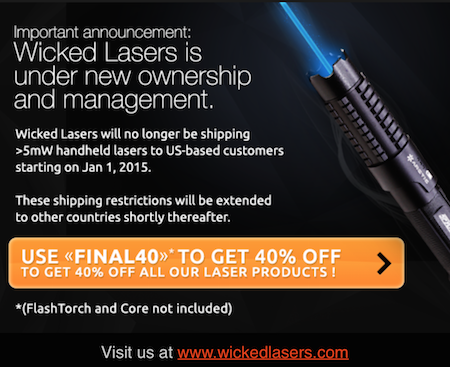
From the email announcement Wicked Lasers sent to customers on Nov. 19 2014 (shown above).
UK: 107 laser pens seized from house near Southampton Airport
In the ten weeks prior to September 26 2014, there were seven incidents of lasers being pointed at aircraft; five of these led to arrests.
News reports did not directly link the misuse to the man arrested with the 107 laser pens. It also is not known if the investigation that led to the seizure was started in response to the aircraft incidents, or was separately initiated. All flights landed safely.
One of the seized pens was said to be 650 times more powerful than normal. Given that U.K. regulations prohibit laser pointers above 1 mW, the pen was likely 650 milliwatts. This is Class 4, the most hazardous laser classification, as the beam can cause eye and even skin burns.
From the Daily Echo
US: Famous DJ explains why he had to have a 2 watt laser pointer
Avicii answered “I just bought a really awesome laser pointer. It's two watts, so it's five hundred times stronger than those regular green laser pointers. If you were standing on top of the Empire State Building with it, you could see all the way to Philadelphia. It's dangerous. You can't really play with it. You need to use goggles or you could go blind. But I saw some YouTube videos where it set stuff on fire, and I was like yes. It cost $1,500. That's not too bad for such an amazing invention.”
From Rolling Stone
US: FDA asks Customs' help on illegal imports of laser pointers
Using Form 2877, the importer must submit information on each shipment and must affirm that the products comply (or do not comply) with FDA laser regulatory standards. But if a small package omits Form 2877 and is mislabeled (not using the word “laser”), this is an attempt to evade FDA and Customs. FDA specifically notes that such single-package Section 321-type imports do not meet the FDA’s criteria for enforcement discretion for personal importation.
Lasers that FDA is interested in include laser pointers, laser gun sights, laser levels, laser light shows, laser pointer key chains, veterinary laser products, laser illuminators and similar products. If a shipment does not meet FDA requirements, it can then be detained by the FDA and would not be allowed into the country.
From STR Trade Report. Thanks to New Aje Lasers for bringing this to our attention.
US: Amazon.com tightens rules for laser pointer sales
The new Amazon.com policy requires pre-approval of laser pointers and related products. The products are limited to Class 3R (5 mW) or less and must be branded; examples include Kensington, Quartet, 3M and Logitech. Products must have a testing report from Intertek, UL or SGS.
It is not known if this is a U.S.-only policy or if it extends to other non-U.S. Amazon sites.
Click to read more...
US: FDA warns parents of dangers of laser toys; issues draft guidance
In an August 6 2013 press release and Consumer Health Information article, FDA warned parents that lasers operated unsafely can cause serious eye injuries and even blindness. FDA said injuries from lasers can go unnoticed for days or weeks since there is no pain. But vision can slowly deteriorate over time, eventually causing permanent eye damage.
FDA gave the following as examples of children’s toy laser products:
- Lasers mounted on toy guns that can be used for “aiming”;
- Spinning tops that project laser beams while they spin;
- Hand held lasers used during play as “light sabers”;
- Dancing laser beams projected from a stationary column; and
- Lasers intended for entertainment that create optical effects in an open room.
Interestingly, the FDA’s press release and article gave tips on safe usage, including not aiming at car drivers or sports players -- but did not say that it is unsafe and illegal to aim at aircraft.
On August 7 2013, FDA issued draft guidance for industry on minimizing the risk of lasers in children’s toys. Comments are invited within 90 days of the Federal Register publication of the guidance, or by November 4 2013. The draft guidance is reprinted below.
Click to read more...
World: Summary of papers presented at International Laser Safety Conference 2013
Laser pointer hazards for pilots
- A study of the actual output of 40 laser pointers, with powers up to 1.5 Watts, showed significant differences between measured and calculated hazard levels. In some cases, the actual hazard measured at some spots inside the beam was three times the estimated hazard. This is due to the laser output not being smooth in all cases, but instead the beams having “hot spots”. The study also showed that windscreens reduced the beam irradiance -- which is safer for pilots -- from 5% to 60%. (Note however that the McLin study described below showed that windscreens also spread the beam and thus increase glare.)
- A discussion of how being inside the Nominal Ocular Hazard Distance of a laser beam does NOT mean instant blindness for pilots and others.For example, consider a 1 Watt, 1 milliradian laser where the recommended safety distance (NOHD) is 733 feet. If possible, you should be at least 733 feet from the laser before exposing an eye to the direct beam. What is the actual hazard? At 232 feet from this laser, there is a 50/50 chance of the beam causing a barely observable retinal lesion under laboratory conditions where the laser and eye are fixed in place. Due to motion of the aircraft and hand-holding the laser, the chance of a retinal lesion is likely to be less. The distance from 232 feet (“ED50”) out to the NOHD at 733 feet is a known “safety factor” where the chance of retinal injury decreases even further. At the NOHD there is a “vanishingly small risk of hazardous exposure” (Sliney, 2013). Police and other first responder pilots can use this information to better weigh the risk of laser exposure to laser light vs. the benefits of completing a mission (rescuing a person, apprehending criminals, etc.). This presentation also discusses ways to make flight near lasers safer for pilots. A PDF file of all the slides presented is here.
For additional ILSC 2013 papers, click the “read more” link.
Click to read more...
UK: Seizure of 7,000+ laser pointers illustrates control problems
7,378 lasers were seized, along with 8,780 parts from which lasers could be assembled. It was estimated that the company sold over 35,000 laser pointers from 2009-2011, generating income of over £1,000,000 (USD $1,600,000).
Techyun Hii, 33, pleaded guilty to four charges of laser pointer violations and a fifth charge of unsafe power chargers. He was sentenced to a 180 day jail term suspended for 18 months, and to 300 hours of community service. The lasers were later incinerated in a hospital’s furnace.
Lead author John O’Hagan detailed the HPA’s findings in a paper presented at the March 2013 International Laser Safety Conference in Orlando. The case had previously been reported by LaserPointerSafety.com.
Click to read more...
US: Government agency finds most laser pointers they purchased are overpowered
The findings were made public at a March 20 2013 meeting of the International Laser Safety Conference.
Researcher Joshua Hadler designed the measurement device to be accurate, inexpensive and easy-to-use. It would cost roughly $2000 in equipment costs to make a copy of the NIST device; plans are available from NIST for interested parties.
From a NIST press release, March 20 2013.
Click here for the full press release:Click to read more...
Australia: Ban on laser pointers has been a "detriment" to safety
The author, Trevor Wheatley, is chair of the Standards Australia SF-019 Committee on laser safety. He studied 41 lasers purchased online in 2012 that were claimed by the sellers to be legal -- lower than the Australian import limit of 1 milliwatt. Most cost less than AUS $20.
Wheatley found that 95% of these pointers were illegal under Australian law, with outputs above 1 mW. Of the 41, 78% were between 5 mW and 100 mW. (5 mW is generally taken to be the highest safe power for a general purpose laser pointer.)
Based on Wheatley's research, "...there would appear to be a greater than 50% chance that someone attempting to buy a 'safe' laser pointer would inadvertently get a hazardous laser." Further, 100% of the tested laser pointers below $20 "would represent prohibited weapons in most Australian states."
From other statistics, the paper states that "availability has not been significantly impacted." In 2007/2008 there were 648 incidents involving lasers pointed at aircraft. In 2010/2011, well after the import and possession restrictions, the number of incidents had increased to 828.
Click to read more...
US: Myrtle Beach area proposed ban on laser pointer sales
The ordinance would make it illegal to sell lasers over 1 milliwatt, or to sell any green laser to persons under 18. Adults misusing lasers would be charged with assault and battery, with a fine of up to $500, up to 30 days in jail, and being held liable for any damage or personal injury. Minors misusing lasers would be prosecuted in Family Court, plus parents would be held responsible and could be fined or jailed.
In addition, a warning would be required with the sale of every laser pointer.
Under county procedure, it takes three “readings” at council meetings to pass an ordinance. Based on the council’s schedule, the earliest it could be passed would be in January 2013.
From CarolinaLive. This is part of continuing stories at LaserPointerSafety.com about ongoing problems at Myrtle Beach and North Myrtle Beach.
US: Myrtle Beach considering further laser regs; current ones aren't working
A meeting was held with local officials, including representatives from Myrtle Beach, the Coast Guard, the Chamber of Commerce and the Horry County Council, to discuss options. The director of airports said that existing ordinances are not enough. He wants “a way to look at regulating the size and power of lasers that are sold in our community and region.”
Rather than local cities passing ordinances, one approach is for county-wide regulations. The topic will continue to be discussed at future county council meetings.
From CarolinaLive. This is part of continuing stories at LaserPointerSafety.com about ongoing problems at Myrtle Beach and North Myrtle Beach.
US: 198 calls to police about lasers in 3 months; Coast Guard "cracking down" in Myrtle Beach
The local Coast Guard echoes the concerns. Twice in two weeks, search and rescue missions were ended prematurely because of lasers being aimed at helicopters. (See a report here.) Under Coast Guard regulations, after laser exposure the aircraft is grounded and the pilots are medically evaluated before being allowed to fly again.
The Coast Guard issued a letter asking the public to stop aiming at aircraft, and saying that they want to enforce South Carolina’s state law against lading aircraft. The letter is reprinted below (click the “Read More” link).
From WMBF News. This is part of continuing stories at LaserPointerSafety.com about ongoing problems at Myrtle Beach.
Click to read more...
Australia: Illegal laser imports up 60%; threaten aircraft safety
Illegal imports of laser pointers explode - 24 July 2012
Customs and Border Protection is warning travellers and online shoppers about Australia’s tough laws prohibiting the import of laser pointers.
This follows a dramatic increase in the number of these dangerous items being seized by officers at the border.
In the past year, the number of laser pointers seized by Customs and Border Protection officers at the Sydney International Mail Centre alone has increased by close to 60 per cent, from around 9,000 to over 14,000.
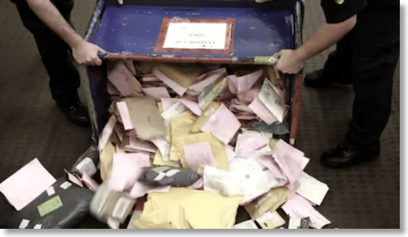
Australian import officers spill out a container full of confiscated packages of illegally-imported laser pointers.
Importing laser pointers greater than one milliwatt in intensity is prohibited in Australia without a permit.
“The sheer volume of these importations suggests that people do not understand the threat these items pose to safety, particularly to commercial aircraft,” said National Manager Cargo Operations, Jagtej Singh.
Customs and Border Protection officers are trained to detect prohibited and restricted items from the millions of items which arrive each week.
“If you try and import laser pointers without a permit, there’s a high possibility they’ll be found by Customs and Border Protection, seized, and you may even face fines of up to $275,000.”
Customs and Border Protection has produced a video clip outlining the risks being taken by people who inadvertently or deliberately breach the laws on laser pointers.
It can be viewed on the agency’s YouTube channel.
According to this video, “Customs officers screen all incoming mail imported into Australia, and items such as laser pointers WILL show up on X-ray.”
Media enquiries: Customs and Border Protection Media (02) 6275 6793
From Australia Customs and Border Protection
UK: UPDATED - Selling illegal laser pens could net a 3-month sentence for UK man
33-year-old Techyun Hii ran Sky Laser Pointers from his home in Ribbleton, a suburb of Preston, Lancashire. In 2011, Lancashire Trading Standards officials found he had lasers that were up to 150 milliwatts, substantially over the U.K. limit of 1 milliwatts for laser pens sold to the public through an eBay store. Three packages were being sent to Greece, just before the Greek riots. He had been warned twice before about U.K. laws and his obligations.
In April 2012, investigators placed a test purchase which led to Hii’s arrest. He pleaded guilty to five counts of selling illegal goods, and will be sentenced July 4 2012.
From the Lancashire Evening Post
UPDATED November 25 2012: Hii was sentenced to a 180 day jail term, suspended for 18 months and was ordered to carry out 300 hours of unpaid work. The lasers sere destroyed by burning them in a hospital’s furnace. From the Lancashire Evening Post.
UPDATED March 22 2013: The case was the subject of a paper in the Proceedings of the 2013 International Laser Safety Conference, “Laser Product Assessment for Lancashire County Council Trading Standards Service” by John O’Hagan, Michael Higlett and Marina Khazova, pp. 181-188. A summary of the paper is here at LaserPointerSafety.com.
UAE: Concern over lasers in Dubai and Abu Dhabi
DragonMart in Dubai claims to be “the largest trading centre for Chinese products outside mainland China,” with almost 4,000 shops. A Gulf News reporter found shops selling lasers under-the-counter for AED 40 to AED 80 ($11-$22). An internet search turned up lasers for sale in Dubai and Abu Dhabi around AED 500 ($136) that were described with terms such as “draw a line in the sky,” “extremely bright green,” and could cause “permanent eye damage”.
The article noted that United Arab Emirates officials have said that illegal use of lasers could lead to fines and jail time.
From GulfNews.com and DragonMart. We have found two articles about youths in Abu Dhabi being arrested after aiming lasers at a helicopter, in June 2010 and in October 2007. Video of the June 2010 incident, uploaded by the Abu Dhabi Police, is available on YouTube (click the photo to go to the YouTube page).
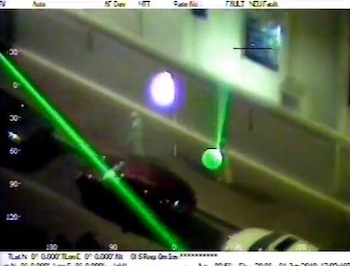
Two lasers, one from the left and one from the center, are briefly aimed at an Abu Dhabi Police helicopter, in a June 2010 video.
US: 3 sheriff's officers charged with illegal laser sales
92 laser sights and 74 automatic machine guns were ordered between Sept. 2008 and January 2010 on Lake County letterhead and purchase orders. The officers paid for the products with personal funds. The amount earned from Internet resales was not stated, although the three officers were also indicted for understating their personal income by a total of $387,000.
The laser products came from Insight Technology Inc. and Laser Devices Inc. The 92 restricted laser sights were purchased for approximately $1000 to $1400 each and were sold on eBay for around $2800 to $4200 each. A special agent of the U.S. Food and Drug Administration (which regulates laser devices) made an undercover purchase as part of the evidence-gathering process in the case.Click to read more...
US: LIA warns against dangers of laser pointers
LIA did not give specific recommendations to avoid eye injuries, other than individuals being cautious. They did note that “[t]here is an active debate about what should be done. Is the solution education, regulation or prohibition for this type of hand-held laser device?…. Until the time that these lasers are statutorily banned, regulated through licensing or are widely recognized as a hazard, many more injuries will occur. The public should take note of these dangers immediately and keep these high-power, hand-held devices away from children and the untrained user.”
Full text of the July 26 2011 press release from LIA News is below (click the “Read More…” link).Click to read more...
Worldwide: Laser pointers reach 2000 milliwatts (2 watts)
To give an idea of its power, here are some comparisons:
- The U.S. limit for a laser to be sold as a pointer is 5 mW (0.005 watt). The new lasers are 400 times more powerful than a “legal” laser pointer.
- The infamous Wicked Laser Spyder III Arctic is nominally a 1000 mW laser (1 watt). However, most Arctics actually emit around 800 mW, so if the new lasers really reach 2000 mW then they are 2.5 times as powerful as a Wicked Arctic.
- The most dangerous laser classification, Class 4, begins at 500 mW (1/2 watt) for visible light. Class 4 lasers can cause instant eye damage, skin burns, and can be a fire hazard for certain materials. The new devices are four times the minimum for a Class 4 laser.
- A 2000 mW laser is an eye hazard up to about 1,000 feet away from the laser.
Germany: Homemade laser pulse gun packs 1-megawatt punch
This differs from most pointers and handheld lasers, which use lasers that emit continuous light. This one emits a single, strong pulse each time the trigger is pulled. It is “enough to punch holes in plastic sheets, scorch wood, and pop balloons from several feet away” according to Dvice.com.
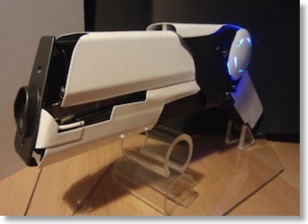
The maker, Patrick Priebe, posted a YouTube video showing the gun in action. He also was offering it for sale. According to Priebe, the gun uses a Q-switched Nd:YAG laser. It takes four seconds to charge the capacitor; the gun then fires a 100 nanosecond, 1 megawatt burst of infrared 1064 nanometer light. The gun took Priebe about 70 hours to build. His YouTube page offers to help others wanting to build their own laser gun.
SAFETY NOTE: Because the laser emits an invisible pulse, it would not be a visual interference hazard to aircraft (e.g., it could not cause glare or flashblindness). At close range the Q-switched pulse would definitely be an eye hazard, causing an explosive steam “pop” on the retina rather than the relatively slow burn of a continuous-wave laser. LaserPointerSafety.com has not done an analysis to determine the “safe” distance, beyond which it would not pose an eye hazard to pilots or others.
From Dvice.com and Hacked Gadgets forum
US: NY Times says injury increase feared from higher powered lasers
The article listed four injuries to youths. In three of the incidents, a young person deliberately stared into a laser beam, while the fourth was caused by a high-schooler whose friend waved a 50 mW laser in his face. (Besides these anecdotal accounts, the article gave no overall statistics on injuries except to say that an ophthalmologist association is “unaware of any increase in eye injuries caused by lasers.”)
Author Christine Negroni covered a number of topics, including:
- There has been “ninefold increase over five years” in laser illuminations of aircraft
- Eye doctors are “shocked” that high-powered lasers are available on the Internet with no purchase restrictions.
- A U.K. physician says the U.S. limit should be 1 mW, that even at 5 mW laser pointers have “acute” dangers.
- FDA says that noncompliant (“illegal”) lasers are available despite agency seizures.
- Wicked Lasers says that its products are compliant, that they are “extremely clear” about eye and fire hazards on their webpages, and that they will be offering online safety lessons “before checkout”.
- A “large community” of laser enthusiasts wants to keep lasers available.
- An 18-year-old laser hobbyist, who wears goggles and is supervised by his parents, said he was learning about electronics, soldering, physics, light, optics and mechanics.
From the New York Times, online on Feb. 28 2011, in print on March 1 2011 on page D5 of the National edition.
US: FDA warns of risk from high-powered lasers
The announcement, dated a week before Christmas said “high-powered laser pointers” are “illegal and potentially dangerous.... The FDA wants to make consumers aware that they should not buy these lasers for themselves or as gifts for others.”
The announcement noted that “many eye injuries from laser pointers go unreported.” Of reported injuries, FDA said in 2010 they were aware of three incidents involving children playing with laser pointers. One of these caused damage “from reflected beams after directing a 150 mW laser pointer into a mirror.”
FDA also described incidents of pilots experiencing temporary flash-blinding. In 2009, pilots reported 1500 incidents; in the first 10 months of 2010, there were 2321 incidents. FDA noted in boldface that “Using a laser to illuminate aircraft is a federal crime.”
FDA listed five recommendations:
- Do not let children own or use laser pointers.
- Do not buy any laser pointer over 5 mW
- Do not aim laser pointers at any “person, pet, vehicle or aircraft” either directly or through reflections.
- If you own a laser pointer over 5 mW, “dispose of it safely according to local environmental protection guidelines.”
- If you are injured, see your eye doctor
The complete safety notification can be found on this FDA webpage, and is also reprinted here (click on the “Read more...” link).Click to read more...
Worldwide: Dangerous 1 watt laser on sale for only $200 (+ updates)
Wicked Lasers advertises the 1 watt Spyder III Pro Arctic as “the most dangerous laser ever created”. This is not far from the truth; it is by far the most dangerous laser affordable by the general public. Previously, such a laser would have cost many thousands of dollars.Click to read more...
US: New FDA publication on laser pointer hazards
FDA is especially concerned about laser pointers above 5 mW, and about aircraft incidents. “In 2008, pilots reported a total of 950 cases of laser light striking an aircraft or illuminating a cockpit....The distraction from flash blindness could cause a serious accident.”
Click to read more...
UK: eBay, Amazon remove high-powered pointers
The move follows a BBC investigation which found some of these potentially dangerous products were being sold irresponsibly by individual traders.
Click to read more...
Poland: Scientific paper says laser toy is misclassified, 4x legally required power
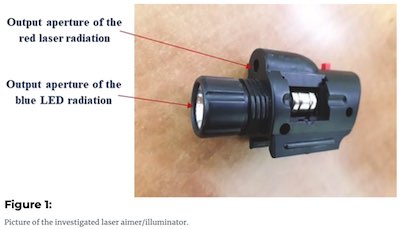
The paper examined the red laser's output and found it was 1.7 milliwatts. This is four times the Class 1 limit of <0.39 mW, and is 1.7 times the Class 2 limit of <1 mW. The laser should have been classified as Class 3R (<5 mW limit).
The author notes that according to the European standard EN 62115:2020, and guidance from Public Health England, laser toys should be Class 1. At four times the Class 1 limit, this toy's "radiation may be hazardous, especially when looking into the beam for long periods."
From Mlynczak, Jaroslaw. "Laser toys fail to comply with safety standards – case study based on laser product classification" Advanced Optical Technologies , no. (2021). https://doi.org/10.1515/aot-2020-0072
COMMENTARY FROM LASERPOINTERSAFETY.COM
We do not dispute Mlynczak's technical findings. However, there are some misleading or false statements in the paper that we would like to address.
- An erroneous title; it should be "Laser toy fails to comply…" The case study is not about "toys" plural. It covers only one sample of one toy rifle which had a laser aiming device that was found to be misclassified.
- Stating that the toy laser's output power (1.7 mW) is illegal, when it may have been legal or close to legal (within 0.7 mW) at time of sale.
- Calling the laser's light output "radiation" 14 times and never using the more precise term "light," thus giving a misleading impression the hazard might be similar to that of X-radiation or nuclear radiation.
- Stating without any proof or reference that children "will usually try to look directly into the laser beam."
- Stating without any proof or reference that children "could have temporary disturbances of vision… lead[ing] to a tragedy."
- Stating without any proof or reference that there is such a thing as "hypersensitivity to laser radiation."
- Stating without any proof or reference that "the described laser toy… [is] easily available and [is] still sold as toys in many European states."
- Listing in the References studies claiming laser "toy" injuries, which actually were from standard, non-toy laser pointers.
Details are below:Click to read more...
